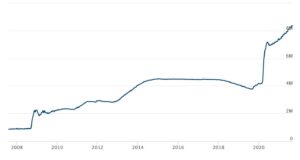
The Polyhedra Network interoperability protocol has formed a partnership with Google Cloud that will allow the expansion of the use of ZK proofs on the Polygon, Linea, and Lita networks.
Together the cryptographic project and the cloud computing platform have launched the benchmarking tool “Proof Cloud”, leading to a significant reduction in computational costs on blockchain.
In the meantime, it is worth noting how Polygon is advancing its challenge to create a layer with unified liquidity, powered by ZK technology.
Let’s see everything in detail below.
Polyhedra Network and the collaboration with Google Cloud: the test on the blockchain environments Polygon, Linea, and Lita
Polyhedra Network has just announced the launch of the “Proof Cloud” service together with Google Cloud, with a test scheduled on the Linea, Polygon and Lita chains
The famous web3 protocol focused on cross-chain asset transfer made the news public during the Google Zk Summit in San Francisco, which was attended by various cryptographic teams.
Proof Cloud is nothing more than a ZK-as-a-service platform, based on the concept of “zero-knowledge” that developers can leverage in the blockchain field.
The objective is to meet the growing demand for ZK proof technology, through an efficient, fast, and cost-effective infrastructure.
By leveraging this new solution conceived by Google Cloud, it is possible to reduce computational costs by approximately 90%, bringing ZK demonstrators to a new level.
Regarding the excellent news, Polyhedra Network’s Chief Strategy Officer Eric Vreeland commented as follows:
“The goal of Proof Cloud is to make zero-knowledge proofs more accessible to everyone, both in web2 and web3, and we are excited to work with teams like Google Cloud, Polygon, Linea, and Lita to make this possible.”
The launch of Proof Cloud on the Linea, Polygon, and Lita networks also includes the inauguration of the affiliated platform “Proof Arena,” which represents a benchmarking solution.
Thanks to this facilitator, users will be able to maximize the performance of their ZK proofs, visualize comparative results and test the performance of the specific prover architecture.
Through impartial tests, developers can determine how their algorithms compare with others in Proof Cloud and, ultimately, choose the one that best suits their needs.
The latest innovation from Google Cloud opens the doors to new connections for developers in the crypto world, who from today will be able to support various open source proofing systems.
Among these, the Expander ZK tools from Polyhedra, Plonky3 from Polygon, Stwo from StarkWare, and Gnark from Linea stand out.
Regarding this, Sandeep Nailwal, co-founder of Polygon Labs, commented on the good news as follows:
“Tools like Polyhedra’s Proof Cloud are essential to lower the barrier to entry for creation with ZK and add much-needed transparency to the space”.
The importance of ZK proof in the world of digital data of Google Cloud
The presentation of the Proof Cloud service, conceived from the collaboration between Polyhedra and Google Cloud and developed on the Polygon, Linea, and Lita networks, underlines the importance of ZK proofs within the world of data archiving.
Google Cloud has been aware of it for quite some time now, being one of the first cloud computing companies to integrate zero-knowledge technology.
At the end of 2023, it indeed revealed a partnership with the decentralized data platform “Space and Time”, revolutionizing the way query results are verified through ZK systems.
Big news for #BigQuery users: @SpaceandTimeDB‘s decentralized data warehouse and novel ZK proof for SQL operations was recently integrated into BigQuery!
Read how it’s improving Blockchain-based smart contracts for the Web3 space with Google Cloud → https://t.co/1O6gaweuNU pic.twitter.com/SoVJSnRJEO
— Google Cloud (@googlecloud) December 12, 2023
This integration, which leverages the power of the multi-cloud data warehouse BigQuery, ensures that users can verify the correctness of the query results.
All this without revealing the underlying data, thus maintaining privacy and security, and driving the adoption of this technology in the world of digital data.
It is clear that the partnership between Google and the verificatore crittografico represents a milestone for the development of solutions that ensure data integrity on blockchain.
The technology of ZK proof has been fully embraced by the cloud computing division of the tech giant, precisely because the team is aware of the importance of verifiable data.
Most likely in the coming years we will see Google Cloud presenting itself in an increasingly massive way in the integration of ZK technological tools, given their impact on the data market.
Latest news on the Polygon Labs front: unified liquidity on Move-based L2 chains
In addition to the news from Google Cloud and Polyhedra with the launch of the benchmarking solution for the Linea, Polygon, and Lita chains, we must report another great piece of news for the interoperability on blockchain sector.
Let’s talk about the collaboration between the blockchain developer Movement Labs and the software development company Polygon Labs. The purpose of this union is to bring unified liquidity to the L2 networks based on the Move programming language.
In detail, AggLayer serves as an operational base to connect MoveVM, AggChains, and Ethereum, addressing the critical issue of fragmented liquidity in web3.
The infrastructure will use the data availability layer of Celestia, providing a cost-effective and high-throughput solution for off-chain transaction data storage.
At the same time, the inherent security of the Ethereum environment will be maintained.
Big News: Movement is connecting to AggLayer!
We’re collabing with @0xPolygon to unify liquidity across:
MoveVM-based L2s
All AggLayer chains
Ethereum
Movement is the first next-gen ecosystem on AggLayer, bridging the gap between the Move and EVM worlds. pic.twitter.com/jdwriA7fRi
— Movement (@movementlabsxyz) July 30, 2024
By joining Polygon’s “AggLayer”, Movement Labs bridges the existing gap between Move communication and EVM, aiding the interconnection of capital.
The announcement, revealed yesterday on X, coincides with the launch in public testnet of the Movement network, which has already attracted an impressive TVL of 160 million dollars.
A good portion of this amount, already committed before the mainnet launch, was sponsored by the Solv Protocol project. The pioneer of the Decentralized Bitcoin Reserve contributed 100 million dollars to raise the TVL of Movement.
As reported by Rushi Manche, co-founder of Movement Labs, regarding this news:
“Our platform addresses a critical need in the Web3 ecosystem. Developers no longer have to choose between the reliable Ethereum environment and the security of alternative L1s. Movement offers the best of both worlds: the familiarity of an Ethereum L2 with the enhanced security and performance of the Move language. This allows projects to be deployed with confidence, knowing they are protected from common vulnerabilities while still leveraging the economic strength of the Ethereum ecosystem”.














